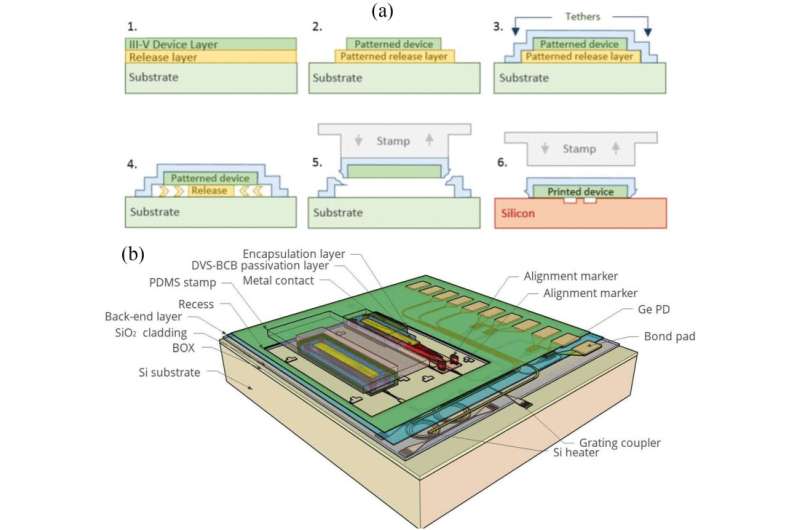This article has been reviewed according to Science X's editorial process and policies. Editors have highlighted the following attributes while ensuring the content's credibility:
fact-checked
proofread
Micro-transfer printing for heterogeneous Si photonic integrated circuits

Are you feeling nostalgic for homogeneous integration of chips—one flat board where you can use your fingers to stuff in all the circuitry you need? It might be best to head to the Lego store. The rest of the world is moving fast to heterogeneous integration—where the boards are 3D, the chips are a mix of electronic and photonic functions, and every specification is in nanometers. It just as challenging as it sounds, but much more fun.
About 550 miles from Lego headquarters, in Belgium, a group of researchers have developed a new integration approach, micro-transfer printing (μTP), that combines the advantages of die-to-wafer bonding integration (high throughput integration) with those of flip-chip integration (pre-fabrication and pre-testing of the nonnative components, high alignment accuracy integration, no disruption of silicon photonics (SiPh) process flow).
Their work is published in the IEEE Journal of Selected Topics in Quantum Electronics.
The process of flip-chip integration involves putting down an array of solder paste that looks just like the bumps on a Lego brick. Heat the assembly and the bumps form perfect little solder balls that conduct electric signals, thanks to the magic of surface tension. Yet gray solder is not the connection material for transmitting light. Instead, waveguides (aka wires for light) connecting photonic chips are either fabricated at the same time as the rest of the functional devices, or they're made later when the photonic chips are on a silicon platform.
Printed electronic traces and conductive adhesives are used for flexible, commercial electronics today. Printing glass waveguides with a stencil or a 3D printer isn't what this paper describes. Instead, the researchers describe a process more like embossing leather with decals or old-fashioned printing, which is akin to pressing a stamp down on paper. The children's toy known as Silly Putty is 65% polydimethylsiloxane (PDMS), while the stamp the researchers have used is 100% PDMS and transparent.
So, imagine your Lego bricks are on the floor—various heights and shapes. To keep your pattern, but move them all at once, you can stretch out Silly Putty and press it into the Legos. Then you move the putty with the Legos attached over to a board. Press down. Gently peel off the PDMS. Voila, you have transferred Legos in a massively parallel way. The published design provides an impressive 1 μm lateral alignment tolerance. But why transfer at all?
The answer is that it is easier and cheaper to make "III-V devices" on a native substrate. Light-emitting devices need direct band gap materials like InP or GaAs. (These are III-V materials because they pair elements from groups three and five of the periodic table.) The Belgian researchers use III-V materials for their waveguides too. Ultimately though, these micron-sized parts must go onto a silicon substrate, for economic reasons.
The transfer technology is versatile. Other demonstrations of μTP are underway, specifically: InAs/GaAs quantum dot lasers, Ce:YIG magneto-optic materials for optical isolators, periodically poled LiNbO3 for nonlinear optics, and BiCMOS electronics. Scaling up the technology to 200 mm and 300 mm wafers is underway. Researchers are continuously improving device performance (e.g., laserwall plug efficiency) and studying yield and reliability.
However, there is still a way to go for this process to be used as a manufacturing technology.
More information: Gunther Roelkens et al, Micro-Transfer Printing for Heterogeneous Si Photonic Integrated Circuits, IEEE Journal of Selected Topics in Quantum Electronics (2022). DOI: 10.1109/JSTQE.2022.3222686




















